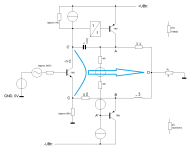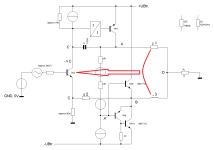And why would nonsense be "complete"?... and of course quiescent current flows no matter how small... even if in the sub fempto-amp region..
A manufacturer would welcome a circuit which does not need an employee tweaking a bias pot during production.
More accurately he would tolerate a little more distorsion if that help savings in the workforce costs,
at the time the 405 wasnt the end of all, and in 1978 the second version went further in class AB for the lower
part of the OS, albeit also with the same cost saving.
Yay. An interesting take on that idea was published by @fakel on the (Russian-speaking) forum.vegalab.ru:The basic configuration is shown below.
Which reminds me of @Nelson Pass referring to the STASIS OPS as a current dumping arrangement.
Which reminds me of @Nelson Pass referring to the STASIS OPS as a current dumping arrangement.
Who unravels the puzzle?
😎
very quick ...

"einfach genial vom Papa"
But by no means any current dumping in sight - ship ahoy.
😉
"einfach genial vom Papa"
But by no means any current dumping in sight - ship ahoy.
😉
Let's stay with the 405, the forefather of the CD, for a while longer. By the way, I think the CD is an ingenious advertising slogan. The CD puzzle could well be solved for all time before Christmas.
Dear
@MarcelvdG,
wouldn't you like to join (us) in the enlightening discussion with a correct analysis?
regards,
HBt.
Dear
@MarcelvdG,
wouldn't you like to join (us) in the enlightening discussion with a correct analysis?
regards,
HBt.
Attachments
There are two elementary viewing directions, the view from the exit (right) into the black box (whose contents are not unknown to us!) and vice versa, from the entrance.
Two points are still missing, the view from right to left and the two BDY77s as current-amplifying elements, the dumpers, which are simply impedance converters. Impedance converters always work in both directions.
Two points are still missing, the view from right to left and the two BDY77s as current-amplifying elements, the dumpers, which are simply impedance converters. Impedance converters always work in both directions.
By the way, if we don't work vectorially here, i.e. strictly observe the argument and the angle, we can give up right away.
But the STASIS circuit from Nelson Pass is simply awesome, without having counted the number of components, I guess there are 8 whole complementary replacement Darlingtons. Are there eight? From eight pairs onwards, you can simply forget about any problems in the transfer area.
HBt.
But the STASIS circuit from Nelson Pass is simply awesome, without having counted the number of components, I guess there are 8 whole complementary replacement Darlingtons. Are there eight? From eight pairs onwards, you can simply forget about any problems in the transfer area.
HBt.
While creating the sketches accompanying the puzzles, Barry White blares into the room via Cambridge Audio -> MF-DAC -> MF A1 -> DIY BORG and takes me back to my childhood, when all was right with the world (not even anymore).
Another tip for resolution, the 405 is a chimera, as long as the BJT number 9 blocks, the situation looks completely different in terms of the replacement circuit diagram than if it were conducting. It is essential that TR9 is temporarily regarded as a switch, not so much when it is switched on as when it is switched off.
Bad, very bad things always happen at the switch-off moment.
The fact that QUAD has changed this in the following models is absolutely no magic, but an absolute necessity.
But the input band limitation to < 40kHz is also a real hammer, apart from the fact that 40kHz corresponds to 2 * 20kHz, i.e. fh = ft/2, which is more of a coincidence and has absolutely nothing to do with "Shannon and Nyquist" here, does it? I honestly have no idea what P Walker may have been thinking, but the current model range of the revived dead brand Quad looks extremely smart, only the German website (with its completely stupid gobbledygook) makes me refrain from investing.
And quite frankly, the technical data is nothing special. It is the standard, no more and no less, THD, for example, less than or equal to 0.03%. I'm not interested in the power, the main thing is that 20W and 4-quadrant operation are ok, fine.
Merry Christmas now
all the best
HBt.
Psst Who can crack the riddle of how the 405 works in terms of its THD miracle? - of its distortion spectrum!
Another tip for resolution, the 405 is a chimera, as long as the BJT number 9 blocks, the situation looks completely different in terms of the replacement circuit diagram than if it were conducting. It is essential that TR9 is temporarily regarded as a switch, not so much when it is switched on as when it is switched off.
Bad, very bad things always happen at the switch-off moment.
The fact that QUAD has changed this in the following models is absolutely no magic, but an absolute necessity.
But the input band limitation to < 40kHz is also a real hammer, apart from the fact that 40kHz corresponds to 2 * 20kHz, i.e. fh = ft/2, which is more of a coincidence and has absolutely nothing to do with "Shannon and Nyquist" here, does it? I honestly have no idea what P Walker may have been thinking, but the current model range of the revived dead brand Quad looks extremely smart, only the German website (with its completely stupid gobbledygook) makes me refrain from investing.
And quite frankly, the technical data is nothing special. It is the standard, no more and no less, THD, for example, less than or equal to 0.03%. I'm not interested in the power, the main thing is that 20W and 4-quadrant operation are ok, fine.
Merry Christmas now
all the best
HBt.
Psst Who can crack the riddle of how the 405 works in terms of its THD miracle? - of its distortion spectrum!
Attachments
Last edited:
One more tip, unfortunately I can't help it:
Always, absolutely always, carry out a static view first, the dc-view, from top to bottom - this is really important.
Secondly, a question: does everyone recognize the bootstrap?
And a final explanation:
Although I have read the publications on the subject at some point in my life, I have already forgotten them. I discarded the Quad405 story for reasons I won't go into here - it was only reactivated by jxdking's thoughts on the subject. I would like to emphasize that I am not copying or stealing from anywhere else, I approach every analysis with an open mind, armed with the techniques of the old masters, my teachers and lecturers.
As a teacher myself, I always work like a WU-LI master.
In this sense,
Tschüß
HBt.
Always, absolutely always, carry out a static view first, the dc-view, from top to bottom - this is really important.
Secondly, a question: does everyone recognize the bootstrap?
And a final explanation:
Although I have read the publications on the subject at some point in my life, I have already forgotten them. I discarded the Quad405 story for reasons I won't go into here - it was only reactivated by jxdking's thoughts on the subject. I would like to emphasize that I am not copying or stealing from anywhere else, I approach every analysis with an open mind, armed with the techniques of the old masters, my teachers and lecturers.
As a teacher myself, I always work like a WU-LI master.
In this sense,
Tschüß
HBt.
Unfortunately, while tidying up and searching for the printed P. Walker article, I only found a hand-drawn sketch that I had once made from memory (just the text describing the function without knowing the real circuit of the 405).
It already shows the full extent of the fairy tale.
It already shows the full extent of the fairy tale.
Attachments
Unfortunately, the principle does not correspond to the reality available as 405.

However, the principle of the take-away-error concept is clearly evident.
#
By means of a limit analysis we can recognize that at the upper (reasonable) limit the error-correcting contribution of the loop cannot be more than about 7%, the rest is contributed by the miracle of local and global negative feedback alone. Since the DC gain (Vuo) is 10^6, at least in this order of magnitude, we could do without the magic if we had a sufficiently biased and complementary OPS - negative feedback stage.
The only thing missing now is the mathematical proof of my and @wahab s assertion. Don't forget, the principle is not identical to the 405 Quad Amp.
HBt.
However, the principle of the take-away-error concept is clearly evident.
#
By means of a limit analysis we can recognize that at the upper (reasonable) limit the error-correcting contribution of the loop cannot be more than about 7%, the rest is contributed by the miracle of local and global negative feedback alone. Since the DC gain (Vuo) is 10^6, at least in this order of magnitude, we could do without the magic if we had a sufficiently biased and complementary OPS - negative feedback stage.
The only thing missing now is the mathematical proof of my and @wahab s assertion. Don't forget, the principle is not identical to the 405 Quad Amp.
HBt.
Last edited:
It is obvious that for sinusoidal (or cosine) time functions the error contribution of the actual output stage is completely eliminated - in theory.
Whether the Quad 405 does this in practice strictly according to the principle alone has, as far as I know, yet to be proven. Or has it?
Where are Jan and Marcel hiding ;-) when you need them?
kindly,
HBt.
The whole dilemma here is the assumption that there are two independent amplifiers, i.e. the SE-A amplifier and the PP-B amplifier, aka the dumper.
But the two parts are not only interwoven, they are one, the first humanoid (hybrid) Cylon, so to speak - responsible for the space jump, the curvature of the continuum.
Monologue finished,
I am also waiting for the (mutual) intellectual exchange ...

☕
But the two parts are not only interwoven, they are one, the first humanoid (hybrid) Cylon, so to speak - responsible for the space jump, the curvature of the continuum.
Monologue finished,
I am also waiting for the (mutual) intellectual exchange ...

☕
Attachments
I don't recall referring to Stasis amps as Current Dumping, but thanks for posting the schematic...
I don't recall referring to Stasis amps as Current Dumping, but thanks for posting the schematic...
Dear Nelson,
You can be 100% sure that I could not have imagined this.
Thank you for this clarification.
All the best,
HBt.
Psst I like all your Amplifiers ... except for these little recent gimmicks, cool, but .... ;-)
- Home
- Amplifiers
- Solid State
- Current Dumping with OPAMP



